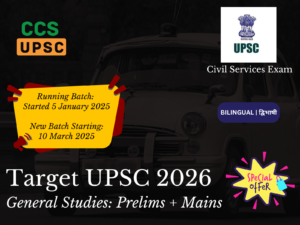Context:
∙ The Supreme Court recently quashed the result of the January 30 Chandigarh Mayor election after finding that the presiding officer had deliberately invalidated eight ballots.
About
∙ The court used its power under Article 142 of the Constitution to do “complete justice” and protect the sanctity of electoral democracy.
∙ Article 142 of the Constitution: Enforcement of decrees and orders of Supreme Court and orders as to discovery, etc
∙ Article 142 of the Indian Constitution allows the Court to pass any necessary decree or order to do “complete justice” in any cause or matter pending before it.
∙ It empowers the Supreme Court with a unique and vast power known as “suo moto jurisdiction.”
Key Features
∙ Discretionary Power: The Court has the sole discretion to invoke Article 142, based on its understanding of “complete justice” in a particular case.
∙ Wide Scope: It applies to any case, irrespective of the subject matter or legal provisions involved.
∙ Binding Order: Any decree or order passed under Article 142 is enforceable throughout India.
Significance
∙ Ensuring Justice Beyond Law: Article 142 empowers the Court to address situations where existing laws and procedures lack adequate remedies.
∙ Promoting Social Justice: The Court has used Article 142 to address issues like prison reforms, environmental protection, and the rights of marginalized communities.
∙ Landmark judgments like the Vishaka Guidelines and the right to education involved its invocation.
∙ Flexibility and Adaptability: Unlike rigid laws, the Court can tailor its orders under Article 142 to specific circumstances, enabling dynamic responses to evolving situations.
∙ Deterrence and Enforcement: The Court’s ability to take suo moto action can deter potential violations of fundamental rights and act as a powerful enforcement mechanism for upholding existing laws.
Landmark Judgements
∙ Sheela Barse vs. Maharashtra (1983): Addressing prison conditions and lack of basic amenities, the Court laid down minimum standards for prison reforms, emphasizing the humane treatment of prisoners.
∙ Olga Tellis vs. Bombay Municipal Corporation (1985): The Court recognized the right to shelter as a part of the right to life under Article 21, ordering the rehabilitation of slum dwellers facing eviction, marking a shift towards protecting informal settlements.
∙ M.C. Mehta vs. Union of India (1987): In this landmark case concerning environmental pollution, the Court invoked Article 142 to issue the “polluter pays” principle, holding industries liable for environmental damage.
∙ Bhopal gas tragedy case (‘Union Carbide Corporation vs Union of India’), 1991: The SC ordered UCC to pay $470 million in compensation for the victims of the tragedy.
∙ Vishaka Guidelines on Sexual Harassment (1997): In the absence of specific legislation on sexual harassment at workplaces, the Court issued these guidelines outlining a framework for prevention, prohibition, and redressal of sexual harassment, setting a crucial precedent.
∙ Right to Education (2002): In response to widespread illiteracy and lack of access to education, the Court declared the right to free and compulsory education for children between 6 and 14 years a fundamental right under Article 21, impacting millions of children.
∙ Irretrievable Breakdown of Marriage (2023): The Court in cases where there is irretrievable breakdown of marriage then dissolution of marriage is the only solution and this Court can grant a decree of divorce in exercise of its power under Article 142 of the Constitution of India.
Criticism of Article 142
∙ Arbitrary: It is argued that the court has wide discretion, and this allows the possibility of its arbitrary exercise or misuse.
∙ Ambiguous: Defining “complete justice” is a subjective exercise that differs in its interpretation from case to case. Thus, the court has to place checks on itself.
∙ Not Accountable: Another criticism of the powers under Article 142 is that unlike the legislature and the executive, the judiciary cannot be held accountable for its actions.
∙ Judicial Overreach: Critics argue that the broad power granted by Article 142 can lead the Court to overstep its boundaries, intruding into the domain of the legislature and executive.
∙ Violates separation of powers doctrine: The power has been criticised on grounds of the separation of powers doctrine, which says that the judiciary should not venture into areas of lawmaking and that it would invite the possibility of judicial overreach.
Views by the Supreme court on the criticism
∙ Prem Chand Garg case (1962): SC held that an order to do complete justice should be consistent with the fundamental rights guaranteed by the Constitution, and also with the substantive provisions of the relevant statutory laws.
∙ ‘Supreme Court Bar Association vs Union of India’ 1998: Powers under Article 142 are supplementary and curative in nature and could not be used to supplant or override a substantive law and “build a new edifice where none existed earlier”.
∙ ‘A. Jideranath vs Jubilee Hills Co-op House Building Society’, 2006: The Supreme Court discussed the scope of the power here, holding that in its exercise no injustice should be caused to a person not party to the case.
∙ ‘State of Karnataka vs Umadevi’ 2006: The apex court has imposed checks on its own power under Article 142.
∙ It clarified that “complete justice” means justice according to law and not sympathy, while holding that it will “not grant a relief which would amount to perpetuating an illegality encroaching into the legislative domain.”
Way Ahead
∙ The Drafting Committee of the Indian Constitution was mindful of the wide-reaching nature of the powers and reserved it only for exceptional situations, which the existing law would have failed to anticipate.
∙ Article 142 represents a powerful tool for the Supreme Court to ensure justice and address societal challenges. However, concerns regarding its potential for misuse and overreach needs judicial restraint.












